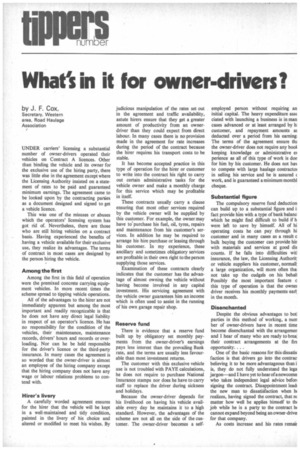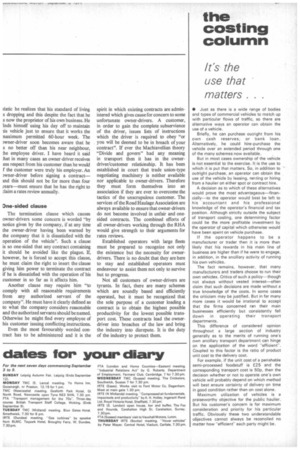What's in it for owner-drivers?
Page 52

Page 53

If you've noticed an error in this article please click here to report it so we can fix it.
by J. F. Cox,
Secretary, Western area, Road Haulage Association UNDER carriers' licensing a substantial number of owner-drivers operated their vehicles on Contract A licences. Other than binding the vehicle and its owner for the exclusive use of the hiring party, there was little else in the agreement except where the Licensing Authority insisted on a statement of rates to be paid and guaranteed minimum earnings. The agreement came to be looked upon by the contracting parties as a document designed and signed to get a vehicle licence.
This was one of the misuses or abuses which the operators' licensing system has got rid of. Nevertheless, there are those who are still hiring vehicles on a contract basis. Having experienced the benefits of having a vehicle available for their exclusive use, they realize its advantages. The terms of contract in most cases are designed by the person hiring the vehicle.
Among the first Among the first in this field of operation were the premixed concrete carrying equipment vehicles. In more recent times the scheme spread to tipping vehicle operations.
All of the advantages to the hirer are not immediately apparent but among the most important and readily recognizable is that he does not have any direct legal liability in respect of an operator's licence. He has no responsibility for the condition of the vehicles, their maintenance, maintenance records, drivers' hours and records or overloading. Nor can he be held responsible for the driver's licence or the third-party insurance. In many cases the agreement is so worded that the owner-driver is almost an employee of the hiring company except that the hiring company does not have any wage or labour relations problems to contend with.
Hirer's livery
A carefully worded agreement ensures for the hirer that the vehicle will be kept in a well-maintained and tidy condition, painted in the livery of his choice and altered or modified to meet his wishes. By judicious manipulation of the rates set out in the agreement and traffic availability, astute hirers ensure that they get a greater amount of productivity from an ownerdriver than they could expect from direct labour. In many cases there is no provision made in the agreement for rate increases during the period of the contract because the hirer requires his transport costs to be stable.
It has become accepted practice in this type of operation for the hirer or customer to write into the contract his right to carry out certain administrative tasks for the vehicle owner and make a monthly charge for this service which may be profitable in itself.
These contracts usually carry a clause ensuring that most other services required by the vehicle owner will be supplied by this customer. For example, the owner may have to purchase his fuel, oil, tyres, repairs and maintenance from his customer's services. In addition he may be required to arrange his hire purchase or leasing through his customer. In my experience, these ancillary and sometimes obligatory services are profitable in their own right to the person supplying those services.
Examination of these contracts clearly indicates that the customer has the advantage of almost owning the vehicle without having become involved in any capital investment. His servicing agreement with the vehicle owner guarantees him an income which is often used to assist in the running of his own garage repair shop.
Reserve fund There is evidence that a reserve fund built up by obligatory set monthly payments from the owner-driver's earnings pays less interest than the prevailing Bank rate, and the terms are usually less favourable than most investment returns.
The customer with this exclusive vehicle use is not troubled with PAYE calculations, he does not require to purchase National Insurance stamps nor does he have to carry staff to replace the driver during sickness and holidays.
Because the owner-driver depends for his livelihood on having his vehicle available every day he maintains it to a high standard. However, the advantages of the scheme are not all on the side of the customer. The owner-driver becomes a self
employed person without requiring an initial capital. The heavy expenditure assc ciated with launching a business is in man cases advanced or at least arranged by hi customer, and repayment amounts at deducted over a period from his earning: The terms of the agreement ensure tht the owner-driver does not require any book keeping knowledge or administrative e) perience as all of this type of work is don for him by his customer. He does not has to compete with large haulage contractoi in selling his service and he is assured c work, and is guaranteed a minimum month! cheque.
Substantial figure The compulsory reserve fund deduction can build up to a substantial figure and ii fact provide him with a type of bank balanc which he might find difficult to build if h were left to save by himself. All of hi operating costs he can pay through hi customer and in many cases as a result a bulk buying the customer can provide his with materials and services at good dis counts. If he falls into difficulties wit] insurance, the law, the Licensing Authorit: or vehicle suppliers his customer, normall: a large organization, will more often thai not take up the cudgels on his behalf Possibly the most important feature o this type of operation is that the owner driver receives his monthly payments earl! in the month.
Disenchanted Despite the obvious advantages to bati parties in this method of working, a num ber of owner-drivers have in recent time become disenchanted with the arrangemen and I hear of many who are ready to breal their contract arrangements at the firs opportunity. . .
One of the basic reasons for this dissatis faction is that drivers go into the contrae believing it to be more advantageous than i is, they do not fully understand the lega jargon—and I have yet to hear of a newcome who takes independent legal advice befori signing the contract Disappointment lead: the new man to dissatisfaction when hi realizes, having signed the contract, that it( matter how well he applies himself to tin job while he is a party to the contract hi cannot expand beyond being an owner-drive for that company.
As costs increase and his rates remair
;lade he realizes that his standard of living s dropping and this despite the fact that he s now the proprietor of his own business. He Inds himself using his day off to maintain us vehicle just to ensure that it works the naximum permitted 60-hour week. The mner-driver soon becomes aware that he s no better off than his near neighbour, he employee driver. I have heard it said hat in many cases an owner-driver receives ess respect from his customer than he would f the customer were truly his employer. An 3wner-ciriver before signing a contract— tad this should not be for more than four ears----must ensure that he has the right to ..tlaim a rates review annually.
Dne-sided clause
The termination clause which causes owner-drivers some concern is worded "by notice given by the company, if at any lime the owner-driver having been warned by the company that it is dissatisfied with the operation of the vehicle". Such a clause is so one-sided that any contact containing it should be avoided like the plague. If, however, he is forced to accept this clause, he must claim the right to insert the clause giving him power to terminate the contract if he is dissatisfied with the operation of his customer in so far as it affects him.
Another clause may require him "to comply with all reasonable requirements from any authorized servant of the company". He must have it clearly defined as to what the company considers reasonable and the authorized servants should be named. Otherwise he might find every employee of his customer issuing conflicting instructions.
Even the most favourably worded contract has to be administered and it is the spirit in which existing contracts are administered which gives cause for concern to some unfortunate owner-drivers. A customer, in order to gain the complete subservience of the driver, issues lists of instructions which the driver is required to obey "or you will be deemed to be in breach of your contact". If ever the Machiavellian theory "Divide and govern" had any meaning in transport then it has in the ownerdriver/customer relationship. It has been established in court that trade union-type negotiating machinery is neither available nor applicable to owner-drivers. Therefore they must form themselves into an association if they are ever to overcome the tactics of the unscrupulous customer. The services of the Road Haulage Association are always available to ensure that owner-drivers do not become involved in unfair and onesided contracts. The combined efforts of all owner-drivers working through the RHA would give strength to their arguments for rates reviews.
Established operators with large fleets must be prepared to recognize not only the existence but the necessity for ownerdrivers. There is no doubt that they are here to stay and established operators must endeavour to assist them not only to survive but to progress.
Not all customers of owner-drivers are tyrants. In fact, there are many schemes which are soundly based and efficiently operated, but it must be recognized that the sole purpose of a customer loading a contract is to obtain the highest possible productivity for the lowest possible transport cost. These contracts lead the ownerdriver into breaches of the law and bring the industry into disrepute. It is the duty of the industry to protect them.










































































































































